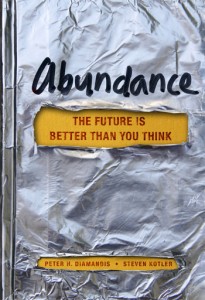The future's so bright...

First, the bad news
Everywhere you look, it seems there's no shortage of bad news. Twenty-four hour news channel shows and broadcast nightly news programs tell the same tale: the world is going to hell in a hand basket. Whether it's news of the latest school shooting, or violence in Syria, or Rick Santorum somehow doing well for himself in the Republican presidential primary race, the message is the same: the future is bleak, and there's precious little we can do about it.
Maybe the world won't end in December like the people who are misinterpreting the end of the Mayan calendar think, but surely the violence, terrorism, and hatred going on in the world today means we can't go on too much longer, doesn't it?
Break out the shades
In their new book, Abundance: The Future is Better Than You Think, authors Peter H. Diamandis and Steven Kotler argue that "The future's so bright, I gotta wear shades" isn't just a song title anymore; it's a reasonable statement given all the best information we have about the world right now. This may seem contradictory to many of us, given the aforementioned constant stream of bad news to which we're subjected, but Diamandis and Kotler make a compelling case that things aren't nearly as bad as they seem.
This idea has been championed in recent years by many others, including Steven Pinker, who speaks about the myth of increasing violence in this excellent TED talk, as well as Hans Rosling, a master at interpreting statistics for normal everyday people.
The bottom line is this: the world in which we live has never been more peaceful than it is now, the vast majority of mankind is healthier (and wealthier, believe it or not) than ever before, and these trends are just going to keep getting better and better in the future. Anyone still holding up signs proclaiming the end of the world is a'comin' may want to rethink their worldview.
Why can't we be more optimistic?
Being so optimistic about the future may strike some people as odd, and Diamandis and Kotler provide several reasons why pessimism is the prevailing view. One major factor is, of course, the news media's focus on negative stories rather than positive ones. This probably comes down to what sells; stories about murder and violence will always generate more attention than those which focus on new medical breakthroughs or technological improvements to day-to-day life.
Also aiding in our pessimistic worldview is the human brain, specifically the amygdala. Evolution has charged the amygdala, the part of the temporal lobe responsible for emotions like hate and fear, to be our early warning system, constantly searching for things to fear and preparing us for the worst at all times. This worked well when there were actually dangers all around us, but in these days of relative peace and prosperity the amygdala still thinks it has a job to do and so keys in on every bit of negativity it can. So the amygdala just loves a news media that benefits from doom and gloom. They're made for each other, it seems.
In addition to the conspiracy between the news media and the amygdala, there are several other things which come to the aid of a negative worldview. Diamandis and Kotler discuss these in some detail, but here's a brief overview:
- heuristics, mental shortcuts or "rules of thumb" that simplify the decision-making process
- confirmation bias, the tendency to look for information that confirms an already-held belief and ignore all evidence to the contrary
- negativity bias, giving more credence to negative information than positive
- anchoring, the tendency to rely too much on a small group of information when making a decision
Overcoming these biases takes a lot of work, but it's work that must be done in order to see the true promise of the future, the book argues.
Four forces changing the world
In Abundance, Diamandis and Kotler list four important forces that are working right now to create this bright future for us all. They are:
- The exponentially accelerating technology rate, i.e., not only is technology improving every year, but the rate at which it improves is itself accelerating, leading to advances in science and medicine that would have been unthinkable only a few short years ago. (For more on this topic, wait for my future hub on Ray Kurzweil and the Singularity or check out Kurzweil's website here.)
- DIY innovators, people who don't wait around for large corporations or governments to solve problems or do the heavy lifting.
- So-called "technophilanthropists" like Bill Gates and Mark Zuckerberg, who have dedicated themselves (and their considerable sums of money) to proactively solving world problems like malaria and education deficiencies.
- The "rising billion," the poorest billion people on the planet who are, thanks to the internet and wireless phone usage, joining the global conversation for the first time and making their voices heard.
All of these forces are interdependent and feed off of each other. Exponential tech has allowed ubiquitous and cheap internet and mobile phone use, so that even some of the poorest people in the world have cell phones and data connections. The increasing importance of technology and social networking in our lives has enabled Gates and Zuckerberg to make their billions, which they are now using to fund programs to solve the world's most immediate problems. And so on.
It's important to note here that technology's exponential progress has never slowed down for anything, including war, famine, terrorist attack, etc. So let the doomsayers preach apocalypse all they want; even if bad things happen, the march of technology, of science, of worldwide betterment, will keep going.
So we can all breathe easy?
Of course the changes that need to take place to ensure a better future won't be easy. The bulk of Abundance isn't about putting on rose-colored glasses and ignoring the real problems that we face today. It's about what we can do -- what we can all do, starting right now -- to bring about the future that we as a species will need to survive.









